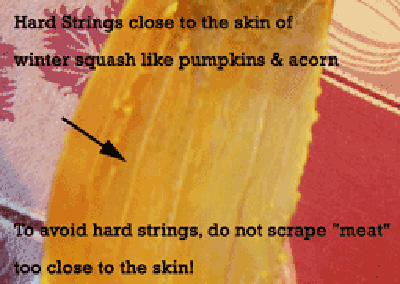 Why Does Winter Squash Have Hard, Strings and Stringy Fibers?
Why Does Winter Squash Have Hard, Strings and Stringy Fibers?
Many people write in to ask about the hard bits and strings that they have found in their butternut, acorn or even pumpkin puree.
What are these strings? Why are there strings in the squash and pumpkin puree? Are the strings in the squash dangerous?
It is not uncommon to find hard “strings” or hard bits in squash purees. Avoiding these hard stringy fibers and stringy bits is relatively simple, once you know how.
Common Reasons For Stringy Fibers In Squash Puree

Here are the two most common reasons why you may find strings and fibers in your otherwise smooth puree.
- Scraping out the squash “meat” too close to the shell: You may find these annoying things in your puree if you have scraped the meat too close to the shell.
- Squeezing or dumping the squash meat straight from the shell/skin: Bits and strings may enter the squash puree when the squash has roasted or baked really well and tender and you are able to “squeeze” the meat from the shell
How to Avoid Getting Stringy Fibers in Squash Puree
To avoid stringy squash purees, don’t scrape too close to the shell when you are getting the squash meat out. No matter how simple it would be, don’t squeeze the meat out of the shell either.
Squash That Often Has Strings and Fibers:
I have found that Acorn squash is the squash that tends to have the most hard fibers and strings. I have had this occur with Hubbard squash and sugar pumpkins a few time but not as often as with Acorn. Seldom have I encountered strings and fibers with butternut squash.
Have you found strings in the squash you cook?
